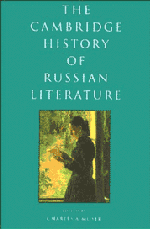Book contents
- Frontmatter
- 1 The literature of old Russia, 988–1730
- 2 The eighteenth century: neoclassicism and the Enlightenment, 1730–90
- 3 The transition to the modern age: sentimentalism and preromanticism, 1790–1820
- 4 The nineteenth century: romanticism, 1820–40
- 5 The nineteenth century: the natural school and its aftermath, 1840–55
- 6 The nineteenth century: the age of realism, 1855–80
- 7 The nineteenth century: between realism and modernism, 1880–95
- 8 Turn of a century: modernism, 1895–1925
- 9 The twentieth century: the era of socialist realism, 1925–53
- 10 The twentieth century: in search of new ways, 1953–80
- 11 Afterword: Russian literature in the 1980s
- Bibliography
7 - The nineteenth century: between realism and modernism, 1880–95
Published online by Cambridge University Press: 28 March 2008
- Frontmatter
- 1 The literature of old Russia, 988–1730
- 2 The eighteenth century: neoclassicism and the Enlightenment, 1730–90
- 3 The transition to the modern age: sentimentalism and preromanticism, 1790–1820
- 4 The nineteenth century: romanticism, 1820–40
- 5 The nineteenth century: the natural school and its aftermath, 1840–55
- 6 The nineteenth century: the age of realism, 1855–80
- 7 The nineteenth century: between realism and modernism, 1880–95
- 8 Turn of a century: modernism, 1895–1925
- 9 The twentieth century: the era of socialist realism, 1925–53
- 10 The twentieth century: in search of new ways, 1953–80
- 11 Afterword: Russian literature in the 1980s
- Bibliography
Summary
After the powerful impetus given Russian literature by the flowering of realism from 1855 to 1880, the period from 1880 – the year when Dostocvsky completed publication of his last novel, and Tolstoy underwent his spiritual conversion – to 1895 was perhaps inevitably a time of lesser cultural energies, although any epoch which contained writers of the stature of a Chekhov is still a remarkable one. In 1894 Alexander III had died after reigning for almost this entire period and taking very little interest in literary matters, unlike most of his predecessors. In literary terms 1895 is the year which saw the creation of Chekhov’s The Seagull – the first of his four outstanding plays which followed upon a period dedicated for the most part to the short story – a major work which incorporated modernist and even symbolist elements, foreshadowing the cultural revival to come.
This transitional period was dominated ideologically by the late Tolstoy, who after his spiritual crisis of 1879–80 turned to moral didacticism in literature, developed a viewpoint which came to be known as Tolstoyanism (advocating primarily non-violent resistance to evil), and gathered disciples about him. In his short story “The Death of Ivan Ilyich” he argued that the most ordinary life is the most terrible life; and in “The Kreutzer Sonata” he suggested that since sexual passion was the root of all evil, human beings might abstain from sexual relations even if this meant the end of the human race.
- Type
- Chapter
- Information
- The Cambridge History of Russian Literature , pp. 333 - 386Publisher: Cambridge University PressPrint publication year: 1992



